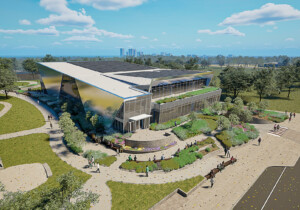In a high-performance building, argues Juan Betancur, director at Adrian Smith + Gordon Gill Architecture, the envelope must never be an afterthought. Rather, it should be a material expression of the overall environmental strategy. “The key to what we’re doing with energy and sustainability is: how do the systems become the facades themselves?” he said. “If we make it part of the building, it’s an integrated systems solution.”
Betancur will outline his firm’s approach to sustainable facade design in a dialog workshop at next week’s facades+ Chicago conference. “Off the Grid: Embedded Power Generation/Net Positive,” led by Betancur with panelists Anthony Viola (Adrian Smith + Gordon Gill Architecture) and Craig Burton (PositivEnergy Practice), will focus on two very different examples of Adrian Smith + Gordon Gill’s recent work: the Federation of Korean Industries (FKI) office high-rise in Seoul, South Korea (2013), and the 174 hectare campus for EXPO-2017 in Astana, Kazakhstan (2017).
In the workshop, Betancur will walk participants through the design process, beginning with site analysis. “The first thing we do is understand the weather data, and get an understanding of what we can do on that particular site,” he explained. “We have our basic toolkit of ideas and systems that can be used both in facades and in buildings overall. Then we begin to take a specific building and see how it works. We see how the building has to be manipulated to take advantage of these conditions.”
Technology plays a critical role in enacting the designers’ sustainability strategy. “We work back and forth with the manufacturers,” said Betancur, exploring, for instance, the application of photovoltaics to a spherical structure. “We look for new technologies, and ask how we can alter them to fit what we’re trying to do, and balance that with economic conditions.” In some cases, as at the Wuhan Greenland Center (2016) the scale tips toward passive rather than active systems. “We’re balancing first costs and life-cycle costs,” said Betancur.
In addition to providing a more elegant design solution, integrated facades are easier for clients to digest, said Betancur. In some cases, as in Seoul, local officials require energy offsets. FKI’s owners signed on to an energy-generating design, he explained, “not because they wanted to, but because the government forced them to.” Other clients prefer solutions that privilege first-cost over life-cycle savings. “The way we approach the basic principle of sustainability is to try not to talk about it as a separate item,” said Betancur. “If we start talking about it as an additive process” clients are likely to balk, he said. Instead, “we say: ‘Here’s an entire building.’ They never think of it as a separate thing, if we can make it work financially.”
To sign up for a dialog workshop or to learn more about facades+ Chicago, visit the conference website.










